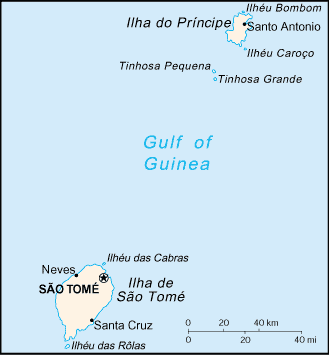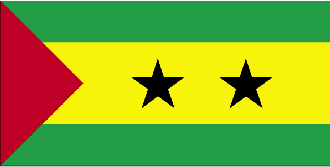
|
Sao Tome and Principe
Background:
Discovered and claimed by Portugal in the late 15th century, the islands'
sugar-based economy gave way to coffee and cocoa in the 19th century - all
grown with plantation slave labor, a form of which lingered into the 20th
century. Although independence was achieved in 1975, democratic reforms were
not instituted until the late 1980s. Though the first free elections were held
in 1991, the political environment has been one of continued instability with
frequent changes in leadership and coup attempts in 1995 and 2003. The recent
discovery of oil in the Gulf of Guinea is likely to have a significant impact
on the country's economy.
Location:
Location: Western Africa, islands in the Gulf of Guinea, straddling the
Equator, west of Gabon.
Area: Total: 1,001 sq km.
Area - comparative: More than five times the size of Washington, DC.
Coastline: 209 km.
Climate and Terrain:
Climate: Tropical; hot, humid; one rainy season (October to May).
Terrain: Volcanic, mountainous.
Natural resources: Fish, hydropower.
Geography - note: The smallest country in Africa; the two main islands form
part of a chain of extinct volcanoes and both are fairly mountainous.
People:
Population: 175,883.
Ethnic groups: Mestico, angolares (descendants of Angolan slaves), forros
(descendants of freed slaves), servicais (contract laborers from Angola,
Mozambique, and Cape Verde), tongas (children of servicais born on the
islands), Europeans (primarily Portuguese).
Religions: Christian 80% (Roman Catholic, Evangelical Protestant, Seventh-Day
Adventist).
Languages: Portuguese (official.)
Government:
Government type: Republic.
Capital: Sao Tome.
Independence: 12 July 1975 (from Portugal).
Economy overview:
This small poor island economy has become increasingly dependent on cocoa since
independence 28 years ago. Cocoa production has substantially declined in
recent years because of drought and mismanagement, but strengthening prices
brighten prospects for 2003. Sao Tome has to import all fuels, most
manufactured goods, consumer goods, and a substantial amount of food. Over the
years, it has been unable to service its external debt and has had to depend on
concessional aid and debt rescheduling. Sao Tome benefited from $200 million in
debt relief in December 2000 under the Highly Indebted Poor Countries (HIPC)
program. Sao Tome's success in implementing structural reforms has been
rewarded by international donors, who pledged increased assistance in 2001.
Considerable potential exists for development of a tourist industry, and the
government has taken steps to expand facilities in recent years.
Statistics:
Telephones - main lines in use: 4,600.
Telephones - mobile cellular: 6,942.
Radio broadcast stations: AM 1, FM 5, shortwave 1.
Radios: 38,000.
Television broadcast stations: 2.
Televisions: 23,000.
Internet users: 9,000.
Railways: 0 km.
Highways: Total: 320 km, paved: 218 km, unpaved: 102 km.
Waterways: none
Airports: 2.
Return to Visiting Locations
|

